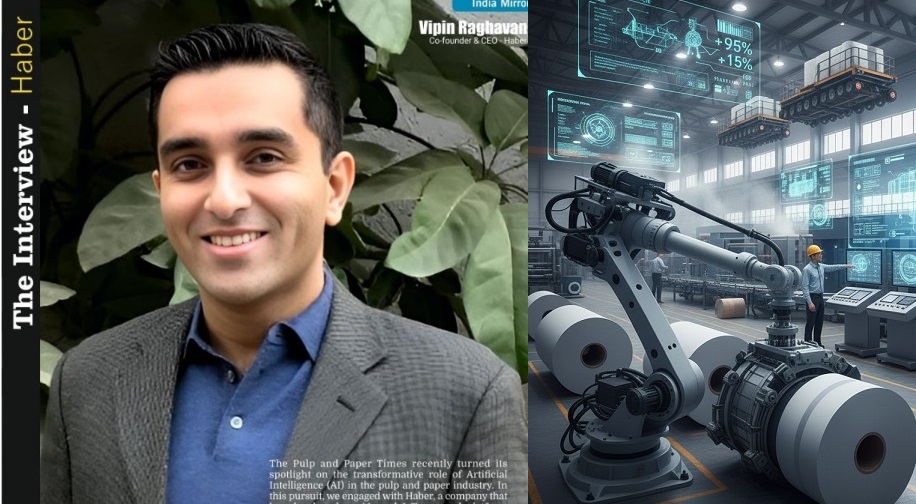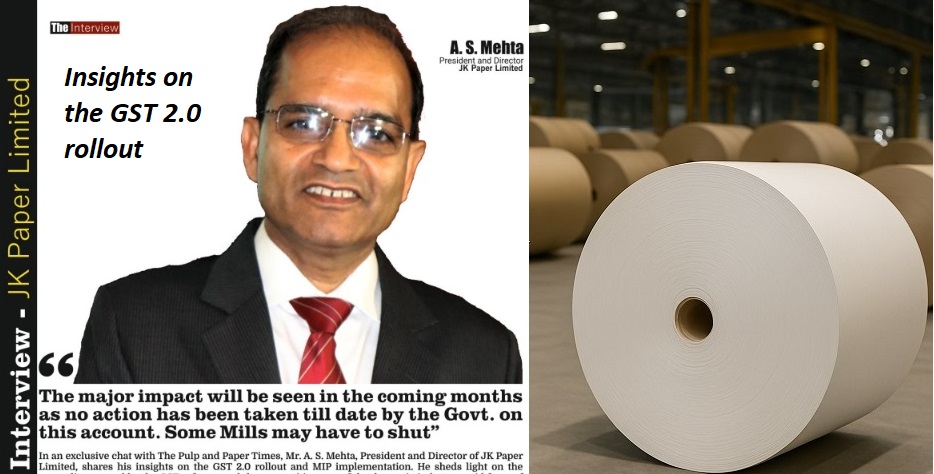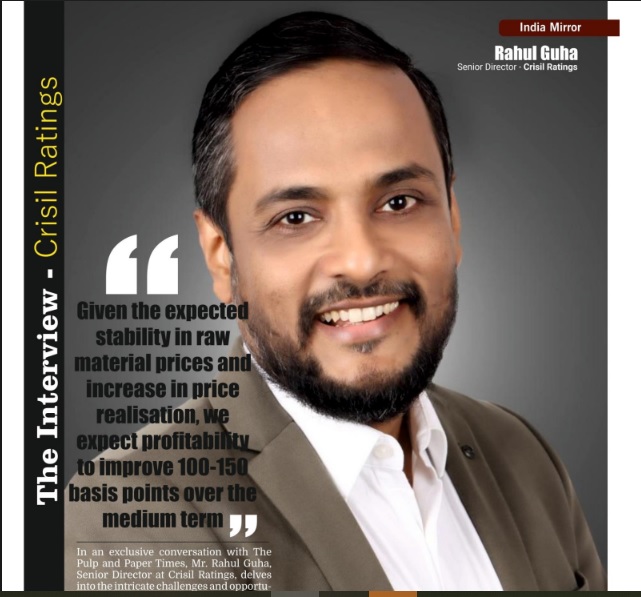"100 GSM paper with GFP can exhibit properties similar to that of 120 GSM developed on the same machine"


"100 GSM paper with GFP can exhibit properties similar to that of 120 GSM developed on the same machine"
There can be a higher price realisation for the paper mills with the enhanced paper quality in picture
Recently, The Pulp and Paper Times got the opportunity to interact with Mr Praveen Kumar Gorakavi, Partner & Co-Founder of The Phi Factory (Gorakavi Innovations Pvt. Ltd.) about his innovation and how this innovation is beneficial to the Paper Mills? Here is his full interview:
June 2021 | The Pulp and Paper Times:
Q: Please give us a small introduction of ‘The Phi Factory’.
The Phi Factory is an innovation platform. Before starting The Phi Factory in 2018, I was a freelancer Scientist. I started my career in science and engineering at a very small age, 13. I got widely recognised as a child prodigy, after recording few world records with my inventions. I was also awarded the then highest civilian award for children from the President of India, Dr.APJ.
Since my 13 until my 29, I have commercialised 28 technologies alongside various companies and corporates internationally. According to one estimate, my works serve a million people on day to day basis. The credits for it should be largely attributed to the FMCG companies I have worked with. My works always were from various fields of Sciences & Engineering, and my speciality is always in New Product Development and Low-Cost Innovations.
After having such an long and successful track record of serving various International companies, I and my cofounder Dr. Meghana Reddy Jale (with whom I have had the privilege of working with earlier on 4 other technology transfers) have come up with an idea of starting The Phi Factory.
The idea behind our startup is simple. We wanted to do what we are best & tested at. Innovation! But the only difference is in the way we operate. Instead of transferring a technology to a major corporate abroad, we’ve observed that the same technologies can be offered as a service to multiple companies within India.
If you observe closely, in todays world, everyday newspaper carries news of some technological advancement from some western country or so., and our own Indian small medium enterprises procure such technologies at very high prices. Stand-alone adoption of such technologies are not financially feasible for smaller businesses.

We wanted to change the scenario. We wanted to cater the Indian companies with the cutting edge technological advancements, not just limited to new product development and low-cost innovation, but we are also into process optimisation and alternate process intensification; help smaller businesses access advanced technologies and empower them with globally marketable products at a very minimum CapEx; which otherwise is a challenge.
This would encourage smaller businesses operate on advanced technologies, which may are fundamentally driven by cost-saving or environmental initiatives, but on a larger front establishes India’s technological self-reliance.
Q: Recently, You manufacture an innovative kraft paper additive for grammage optimization. Please explain your journey behind its development in detail.
At the beginning of our company, we were holding 5 technologies in hand. All of which were ripe enough (post-PoC). We were having a plan to launch one per quarter, and we were to choose which one to start with. G-FP was our choice!
G-FP is a paper additive. It is a biodegradable cross linking polymer that resembles the starch based polysaccharides in its bonding nature (especially with enhanced number of hydroxy groups in the core chemical compound). We chose this product as it was matching my previous work, which was also into packaging, where I have encapsulated fragrance & time-delivered fragrance in packaging (transferred to a major FMCG corporate).
Idea behind G-FP was simple, again !
We know that a lot of fibres are sourced from domestic scrap paper and they might have undergone multiple recycles already, depleting the quality and length of the fibres. To compensate this, we generally opt for a percentage of imported OCC, which may have been made using virgin fibre or probably after 1-2 recycles. Such a combination of domestic and imported scrap pulp is turned into paper.
However, if by some means we can cross-link the domestic fibres and make them appear/perform like longer fibres, it will create independency from imports and also offers consistency in the product. Several DSRs, WSRs, Sizing chemicals and other additives are already serving the market. We wanted to offer the cross-linking, and that thought prompted us to develop our proprietary technology G-FP, a cross-linking chemical composite, which has multiple polymer components in it (biodegradable) and few mineral components for certain characteristics. The base of polymer components is similar to that of starch base, with multiple hydroxy groups to improve the bonding between fibre-fibre and fibre-particle.
We wanted to passively position our product like an environmentally sustainable technology rather than aggressively pushing it as a paper chemical.

Q: The pandemic situation, has disrupted the supply chain majorly for waste paper, Kraft paper price is surging high, how your additive is helping paper mills and corrugators?
AS of now, we are only serving the paper mills and corrugators within our serviceable zones. I’d say we have not actually fully-launched our G-FP but we are in a beta-phase where our MVP is being rolled out for the initial level testings/observations at massive scale (while also serving our patron companies and corrugators/paper mills partners).
Once fully launched and made available for all papermills at large, our offerings would enable Indian paper mills produce High Quality paper products that exhibit extraordinary RCT values despite being built over recycled fibres from the domestic sources. This could also insulate the major fluctuations in the pricing and availability of raw materials that are always influenced by ever-changing International politics and trade movements.
Q: You have claimed in a news story that, your additive is able to make strong paper and but that weighs about 30 percent less. Has your additive been passed any ‘test’ in any Pulp and Paper Research Institute like CPPRI?
We are collecting data from all the papermills and corrugators that we are working with. We are constantly in the process of improving and tweaking the composition to suit a spectrum of raw materials being used across India.
The problem here is diversity! We observed that the operational conditions, source of raw materials, recipes, make of the machine, water circulation & contents, starch dosage, sizing chemicals and their make, speed of the machines, deckle of the machine and many other parameters keep changing as we move from paper mill to paper mill.
Our fundamental objective, as an Innovation company, is not just to offer a single product solution to all possible setups, but to offer a customisable composition (offered as a solution) to each and every papermills partner that we work with; so that the results are achieved at their local operating conditions, matching international standards. We always believe not to simply push the onus of adjustments and dosages to the working team but rather strongly believe on working with them and optimising their produce.
Regarding the weight saving; it is related to the tensile strength our base polymer is set to offer in comparison to that of the paper’s. A relatable paper strength and a G-FP composite dosed paper strength can be compared at any facility.
In fact we encourage people to spray / coat /dip GFP on paper and observe the difference in a lab (before trialing on the plant machinery).
We are yet to approach organisations of national and international importance for official testings/ certifications and endorsements if possible. Since we are only a technology company; we’d be expecting our Licensees and partner manufacturing companies more relevant to apply and pursue such certifications subsequently.

Q: please tell us about its (GFP-Additive) technical use in the paper process.
G-FP is a cross-linking polymeric composite material. There are several improvements and places of dosages we have trialled so far. Let me take you through some important iterations we have performed in the past 30months.
During the launch of the product, we have rolled G-FP in solid formulation. It is technically a dormant additive encapsulated in G-FP polymeric solutions. By encapsulating with a layer of hydroxyl active groups (skinned around the micro-additive particles), we were able to incorporate higher percentage of passive additives such as calcium carbonate or talc, in the paper, with greater retention percentage without effecting the strength of the paper. Theoretically, we could have achieved 45% addition rate, however, during practical field applications we have seen a sharp decline in the performance of the paper after 28-32% w/w solid-GFP with paper.
Thus, I could say that we originally started using the core polymeric solution as an encapsulant to encapsulate passive additives such as calcium carbonate or talc, for an enhanced retention with neutral effects.
During one experimental instance, we have dosed 18% fly ash (which usually floats on water) into the paper, without much change in the mechanical behaviour. We were hoping this could change the solid-waste problem from the paper-mill’s boilers or even at the organisations such as NTPC.
Later, we have observed that dosing ~30% of solids was way more labor intensive than expected. Especially, working unions from few papermills that we’ve worked with suggested us to utilise silos & solid conveyors (while packing solid GFP in sack kraft bags). These inconveniences prompted us to improve the delivery of our core solution.
We quickly switched to the liquid formulation, where the delivery of G-FP core polymeric composition is dosed while eliminating the other constituting fillers. This is currently being served to our partner papermills. Here, we are advising to dose 1% w/w of liquid G-FP over the paper just before the size press or soon after the size press; as few components in the GFP help starch in forming a thermoplastic, thus resisting its retrogradation & ageing effect (which apparently results into cracking and breaking of the corrugated boxes when exposed to tropical environment or upon ageing).
G-FP could also be introduced as a sizing material within the size press; but we advice this to a paper mill only after our team checks the compatibility with other chemicals currently being used.

Our GFP chemical composition has also been tested in few high-speed papermills abroad (pilot scale) and we have seen a very consistent result comparable to that from the Indian paper mills. IN general, a 1% dosage is giving an approximate improvement in the bursting factor of a paper by 6points and an improvement of 6-16% in RCT in both MD & CD.
Recently, we have shared our samples to a white paper company. Interestingly, a 0.3-0.5% w/w dosage of GFP has shown an improvement in stiffness by 30-40% in their facility. We are soon going to conduct a longer version of that trial, to conclude on the consistence in its performance.
I should also say this, we were not successful at all the places of our trial with a generic chemical composition either !
There were several factors that counter-effected the performance of our GFP, like the water hardness, roller speeds, feedstock contamination levels, sizing chemicals, quality of starch & its enzymes performance, etc.
The best part is, GFP is a composite. We have a number of variables that can be altered to create the right combination that a paper mill wants.
And so to achieve a consistent and desired performance; we have made it a point to visit the papermills, collect samples, verify the average quality of feed and then propose the most optimised composition, customised to a paper-mill’s condition (which they can continue thereon, unless there is a significant deviation in their operational conditions). We are of a plan to revisit once every year, to ensure the quality optimisation and tweak the compatibility as required.
In general , the generic GFP composition (base variant) is proved successful in 88% places; while at the remaining places we had to tweak the composition a bit to suit the local operating conditions.
Q: What is your future plan to covering up more paper mills?
We are only the technology providers. The Phi Factory, as a policy, is neither into manufacturing nor supply chain by ourself. We have partner companies that manufacture and sell the product for us. We monitor the quality compliance, and behave like an aggregator of the product (so as to maintain uniform standards pan India).
We have few licensees in both India and abroad that are happy to serve interested paper mills with the GFP base variant. We are also planning to roll out the other upcoming variants and upgrades through similar partnership chains.
Q: The GFP Additive will reduce paper weight by about 30 per cent, which is a direct loss to paper mills as paper is sold in Kgs, how will your company compensate them?
Absolutely not. We are improving the quality of the paper (which is compared to the higher grammage paper for a layman to understand). A paper of, say 100gsm paper with GFP can exhibit properties similar to that of 120gsm developed on the same machine using similar fibres but without GFP. It doesn’t necessarily mean the productivity is decreased; moreover there can be a higher price realisation for the papermills with the enhanced paper quality in picture. Most importantly, increase in the BF, RCT (in case of Kraft) and Stiffness (in case of white paper).
The productivity is not affected at all, except for the fact that a 1% dosage or GFP would increase the moisture content of the paper rolling out through the size press; which would require higher treatment temperatures in the subsequent rollers to match up the productivity.
Q: What is your business model in terms of benefitting all stakeholders of the entire supply chain?
We are an innovation company. AS a policy, we neither invest in machinery or materials. We strongly believe in partnerships. We have licensee companies that manufacture GFP for us; while we oversee the supply chain. We also monitor the quality assurance.

So far, we have been serving selective few corporate clients (who are the end users) via their vendor network, that mostly are integrated packaging companies with both corrugation and paper-mill facilities.
With the support of our partner companies and licensees, we are now trial venturing into positioning GFP as a paper additive; allowing direct sales to selected few papermills. Soon after reaching a balance, as you know we are a start-up and we have our own hustles, we will ramp up the sale and distribution.
Q: What are the other new innovations on which you are working?
In GFP, we are developing a HydroPhobic variant. We are calling it GFP/HP, for the time being. This is capable of creating a heat sealable superhydrophobic cover over the paper upon spray coating. The contact angle of above 150 were observed in our initial Lab trials. This could be a goto solution for a lot of paper-based packaging companies in India to venture into alternate paper-based packaging to the plastics.
We may have noticed that a whiskey company has recently developed paper based bottling technology (due to commercially launch in 2025, if I remember it correctly). Our GFP/HP can be our own Indian Version of such application, a technology completely made in India !
We are also developing a technology to rapidly manufacture bioplastics (especially polylactic acid) via fermentation way. This is expected to take far less CapEx and Ops, in comparison to the conventional methodologies. We will consider partnering with packaging companies to realise this product into market in the first half of CY 2022.
It could give our packaging partners a clear market advantage; as the end-user companies can avail bioplastic at much affordable pricing, if not lower than plastics itself.
Q. How this product will help paper mills on the parameters of productivity & profitability?
GFP will improve the quality of the paper. We are hoping to improve the quality of packaging in the country using our environmentally friendly packing solutions !
Web Title: 100 GSM paper with GFP can exhibit properties similar to that of 120 GSM developed on the same machine




 Join WhatsApp Group
Join WhatsApp Group Join Telegram Channel
Join Telegram Channel Join YouTube Channel
Join YouTube Channel Join Job Channel (View | Submit Jobs)
Join Job Channel (View | Submit Jobs) Join Buy Sell Channel (Free to Submit)
Join Buy Sell Channel (Free to Submit) Paper News Headlines Channel (Free to read)
Paper News Headlines Channel (Free to read)










